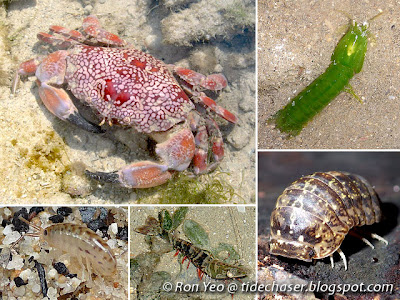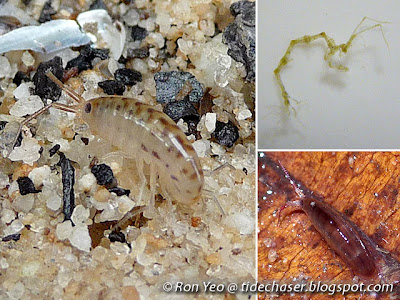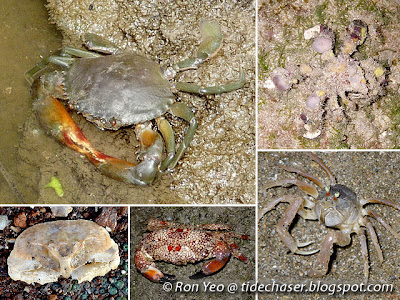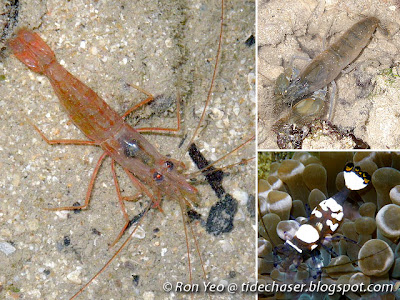The malacostracans (phylum Arthropoda, subphylum Crustacea, class Malacostraca) include the crustaceans that many people are familiar, such as crabs, lobsters, prawns and woodlice.

While they may be very diverse in their appearances, they have several common features. Their body typically comprises three main parts - a head with five segments, a thorax with eight segments, and an abdomen with six segments. The head may be fused with the thorax to form a cephalothorax. They often have a tough exoskeleton strengthened with calcium carbonate, and the carapace (if present) covers the gills but not the abdomen. They have prominent antennae, and up to three pairs of appendages may be modified into mouthparts for manipulating food.
As with other crustaceans, most malacostracans have two pairs of antennae and compound eyes on stalks. The abdomen ends off with a tail-like structure called a telson, and a flattened tail fan is usually present at the tip.
Most malacostracans reproduce sexually, though some are known to reproduce by parthenogenesis (the embryos develop without fertilisation). They usually have separate sexes, though a number of species are hermaphroditic (possessing both male and female reproductive parts), and some may change sex during the course of their lives. Most species carry the eggs until they are ready to hatch, though some release their eggs into the water. For aquatic species, the eggs will hatch into larvae that usually appear very different from the adults. For terrestrial species like the woodlouse, the young may appear similar to the adult but has fewer legs.
A wide variety of malacostracans can be found in Singapore, but only a few groups are readily seen and easy enough to distinguish from others. Hence, I will only include the few malacostracan groups that I have photographed in Singapore in this entry.
A) Mantis Shrimps (Order Stomatopoda)

Mantis shrimps (order stomatopoda) are elongate crustaceans with a pair of enlarged appendages that they carry folded beneath the head, somewhat similar to the forelimbs of a praying mantis. They can be divided into two main groups - the smashers and the spearers - based on the appearance of their striking appendages and how they are used. The smashers have a heavily calcified knob at the tip of the appendages for punching their prey, while the spearers have numerous sharps spines on the last segment of their claws to impale their prey.
B) Amphipods (Order Amphipoda)

Amphipods (order Amphipoda) are crustaceans that lack a carapace and often appear laterally compressed. They are very diverse but often overlooked due to the small sizes of terrestrial and intertidal species. Unlike many crustaceans, their eyes are unstalked, and in front of the eyes are two pairs of antennae. They typically have seven pairs of walking legs (pereopods), with the first two pairs modified to assist in feeding. They have an additional three pairs of swimming legs (pleopods) at the back, and three more appendages (uropods) to help with locomotion.
C) Isopods (Order Isopoda)

Isopods (order Isopoda) probably have the most diverse appearance among the crustaceans, ranging from flattened and bug-like, to longish and worm-like. Most of the ones seen on land and in shallow water have the former appearance though. They lack an obvious carapace, or have a much reduced one. With regards to their diet, some species are scavengers or detrital feeders, some are known to feed on algae, and some parasitise other animals, but generally, little is known about most isopods.
D) Decapods (Order Decapoda)
Decapods (order Decapoda) are very important to human, as many species are edible and important in the fishing and aquaculature industry. The body shapes of different groups differ greatly, from the elongate shrimps and lobsters to the short-bodied crabs. They can, however, be distinguished from other crustaceans by their five pairs of legs ("deca" means "ten", while "poda" means "feet") attached to the thorax. Some of these legs may have been modified to assist with feeding though, and some species may have additional appendages to help with locomotion.
Here are some of the decapods that I have photographed in local waters.
1. Prawns (Suborder Dendrobranchiata)

Prawns (suborder Dendrobranchiata) are distinguished from other similar-looking decapods by having gills that are branch-like. They also do not hold their eggs until they hatch, but release the fertilised eggs directly into the water column. While they are commonly called prawns in the region, they may be referred to as shrimps (not to be confused with the caridean shrimps) in other countries. They have an elongate body, and the first three pairs of legs have small pincers at the tip to assist with feeding. Most of the species seen in Singapore are of the family Penaeidae, and hence they are also often called penaeid prawns.
2. Pleocyemates (Suborder Pleocyemata)
Members of this suborder typically have leaf-like gills or gills made up of unbranched filaments. They usually brood their eggs until they are ready to hatch.
Crabs (Infraorder Brachyura)

Crabs (infraorder Brachyura) can be recognised by their four pairs of walking legs, a pair of clawed arms, a broad carapace, and a very short and flattened abdomen which is usually folded underneath the body. The abdomen of females is usually broader, so as to carry the eggs. Their antennae are relatively short, and their eyes are on stalks. As this is a very huge group with many species, I will provide more details and photos of local examples in a separate page in the near future.
Anomurans (Infraorder Anomura)

Anomurans (infraorder Anomura) include the hermit crabs, porcelain crabs, king crabs and their allies. They are often crab-like, but have long antennae and three or less pairs of obvious walking legs. The number of walking legs may not always be a useful feature though, as some true crabs have some of their legs modified for functions other than walking, and hence may have fewer than four pairs of walking legs. As there are a number of species in this group that I have photographed, I will provide more details and photos in a separate page in the near future.
Caridean Shrimps (Infraorder Caridea)

Caridean shrimps (infraorder Caridea) appear very similar to penaeid prawns, with their elongate abdomen. Their five pairs of legs are all well-developed, but unlike the penaeid prawns, the third pair does not have pincers at the tip. Also, the second horizontal plate of the abdomen is enlarged, covering part of the first segment and the third segment. Unlike the prawns that release their eggs into the water, caridean shrimps brood their eggs under their abdomen until they hatch. As there are a number of species in this group that I have photographed, I will provide more details and photos in a separate page in the near future.
Mud Lobsters & Mud Shrimps (Infraorder Gebiidea)

Mud lobsters & mud shrimps (Infraorder Gebiidea) are burrowing crustaceans with elongate and somewhat flattened abdomens that live mostly in soft-bottoms of intertidal or subtidal areas. The ones with a heavily calcified exoskeleton decorated with spines and tubercles are usually referred to as mud lobsters, while the more delicate members are referred to as mud shrimps. Some species may appear similar to the coral ghost shrimps of the infraorder Axiidea, but can be distinguished from the latter by having pincers on the first pair of legs, and very reduced or no pincers on the second pair, instead of having well-developed pincers on the first two pairs of legs. I will provide more details and photos in a separate page in the near future.
Spiny Lobsters & Allies (Infraorder Achelata)

Spiny lobsters and allies (infraorder Achelata) are not true lobsters, and they can be distinguished from the latter by the lack of true claws with pincers. They have a soft and flexible tail, and a broad tail fan which allows them to swim rapidly backwards over a short distance. The rostrum (a pointy structure at the front of the head) is usually very small or absent. Many species are scavengers, though studies suggest that they may be opportunists which take a variety of food. While lobsters are occasionally seen by divers in local waters, some of the bigger specimens seen could be those released for religious merit-making. The above picture features a Painted Spiny Lobster (Panulirus versicolor) in the main image, and a dead Mud Spiny Lobster (Panulirus polyhagus) in the inset.
References

While they may be very diverse in their appearances, they have several common features. Their body typically comprises three main parts - a head with five segments, a thorax with eight segments, and an abdomen with six segments. The head may be fused with the thorax to form a cephalothorax. They often have a tough exoskeleton strengthened with calcium carbonate, and the carapace (if present) covers the gills but not the abdomen. They have prominent antennae, and up to three pairs of appendages may be modified into mouthparts for manipulating food.
As with other crustaceans, most malacostracans have two pairs of antennae and compound eyes on stalks. The abdomen ends off with a tail-like structure called a telson, and a flattened tail fan is usually present at the tip.
Most malacostracans reproduce sexually, though some are known to reproduce by parthenogenesis (the embryos develop without fertilisation). They usually have separate sexes, though a number of species are hermaphroditic (possessing both male and female reproductive parts), and some may change sex during the course of their lives. Most species carry the eggs until they are ready to hatch, though some release their eggs into the water. For aquatic species, the eggs will hatch into larvae that usually appear very different from the adults. For terrestrial species like the woodlouse, the young may appear similar to the adult but has fewer legs.
A wide variety of malacostracans can be found in Singapore, but only a few groups are readily seen and easy enough to distinguish from others. Hence, I will only include the few malacostracan groups that I have photographed in Singapore in this entry.
A) Mantis Shrimps (Order Stomatopoda)

Mantis shrimps (order stomatopoda) are elongate crustaceans with a pair of enlarged appendages that they carry folded beneath the head, somewhat similar to the forelimbs of a praying mantis. They can be divided into two main groups - the smashers and the spearers - based on the appearance of their striking appendages and how they are used. The smashers have a heavily calcified knob at the tip of the appendages for punching their prey, while the spearers have numerous sharps spines on the last segment of their claws to impale their prey.
B) Amphipods (Order Amphipoda)

Amphipods (order Amphipoda) are crustaceans that lack a carapace and often appear laterally compressed. They are very diverse but often overlooked due to the small sizes of terrestrial and intertidal species. Unlike many crustaceans, their eyes are unstalked, and in front of the eyes are two pairs of antennae. They typically have seven pairs of walking legs (pereopods), with the first two pairs modified to assist in feeding. They have an additional three pairs of swimming legs (pleopods) at the back, and three more appendages (uropods) to help with locomotion.
C) Isopods (Order Isopoda)

Isopods (order Isopoda) probably have the most diverse appearance among the crustaceans, ranging from flattened and bug-like, to longish and worm-like. Most of the ones seen on land and in shallow water have the former appearance though. They lack an obvious carapace, or have a much reduced one. With regards to their diet, some species are scavengers or detrital feeders, some are known to feed on algae, and some parasitise other animals, but generally, little is known about most isopods.
D) Decapods (Order Decapoda)
Decapods (order Decapoda) are very important to human, as many species are edible and important in the fishing and aquaculature industry. The body shapes of different groups differ greatly, from the elongate shrimps and lobsters to the short-bodied crabs. They can, however, be distinguished from other crustaceans by their five pairs of legs ("deca" means "ten", while "poda" means "feet") attached to the thorax. Some of these legs may have been modified to assist with feeding though, and some species may have additional appendages to help with locomotion.
Here are some of the decapods that I have photographed in local waters.
1. Prawns (Suborder Dendrobranchiata)

Prawns (suborder Dendrobranchiata) are distinguished from other similar-looking decapods by having gills that are branch-like. They also do not hold their eggs until they hatch, but release the fertilised eggs directly into the water column. While they are commonly called prawns in the region, they may be referred to as shrimps (not to be confused with the caridean shrimps) in other countries. They have an elongate body, and the first three pairs of legs have small pincers at the tip to assist with feeding. Most of the species seen in Singapore are of the family Penaeidae, and hence they are also often called penaeid prawns.
2. Pleocyemates (Suborder Pleocyemata)
Members of this suborder typically have leaf-like gills or gills made up of unbranched filaments. They usually brood their eggs until they are ready to hatch.
Crabs (Infraorder Brachyura)

Crabs (infraorder Brachyura) can be recognised by their four pairs of walking legs, a pair of clawed arms, a broad carapace, and a very short and flattened abdomen which is usually folded underneath the body. The abdomen of females is usually broader, so as to carry the eggs. Their antennae are relatively short, and their eyes are on stalks. As this is a very huge group with many species, I will provide more details and photos of local examples in a separate page in the near future.
Anomurans (Infraorder Anomura)

Anomurans (infraorder Anomura) include the hermit crabs, porcelain crabs, king crabs and their allies. They are often crab-like, but have long antennae and three or less pairs of obvious walking legs. The number of walking legs may not always be a useful feature though, as some true crabs have some of their legs modified for functions other than walking, and hence may have fewer than four pairs of walking legs. As there are a number of species in this group that I have photographed, I will provide more details and photos in a separate page in the near future.
Caridean Shrimps (Infraorder Caridea)

Caridean shrimps (infraorder Caridea) appear very similar to penaeid prawns, with their elongate abdomen. Their five pairs of legs are all well-developed, but unlike the penaeid prawns, the third pair does not have pincers at the tip. Also, the second horizontal plate of the abdomen is enlarged, covering part of the first segment and the third segment. Unlike the prawns that release their eggs into the water, caridean shrimps brood their eggs under their abdomen until they hatch. As there are a number of species in this group that I have photographed, I will provide more details and photos in a separate page in the near future.
Mud Lobsters & Mud Shrimps (Infraorder Gebiidea)

Mud lobsters & mud shrimps (Infraorder Gebiidea) are burrowing crustaceans with elongate and somewhat flattened abdomens that live mostly in soft-bottoms of intertidal or subtidal areas. The ones with a heavily calcified exoskeleton decorated with spines and tubercles are usually referred to as mud lobsters, while the more delicate members are referred to as mud shrimps. Some species may appear similar to the coral ghost shrimps of the infraorder Axiidea, but can be distinguished from the latter by having pincers on the first pair of legs, and very reduced or no pincers on the second pair, instead of having well-developed pincers on the first two pairs of legs. I will provide more details and photos in a separate page in the near future.
Spiny Lobsters & Allies (Infraorder Achelata)

Spiny lobsters and allies (infraorder Achelata) are not true lobsters, and they can be distinguished from the latter by the lack of true claws with pincers. They have a soft and flexible tail, and a broad tail fan which allows them to swim rapidly backwards over a short distance. The rostrum (a pointy structure at the front of the head) is usually very small or absent. Many species are scavengers, though studies suggest that they may be opportunists which take a variety of food. While lobsters are occasionally seen by divers in local waters, some of the bigger specimens seen could be those released for religious merit-making. The above picture features a Painted Spiny Lobster (Panulirus versicolor) in the main image, and a dead Mud Spiny Lobster (Panulirus polyhagus) in the inset.
References
- Bartlett, T. & J. VanDyk. 2003. BugGuide. Retrieved May 24, 2013, http://bugguide.net.
- Burnie, D. 2001. Animal. London: Dorling Kindersley. 624 pp.
- De Grave, S., N. D. Pentcheff , S. T. Ahyong, T.-Y. Chan, K. A. Crandall, P. C. Dworschak, D. L. Felder, R. M. Feldmann, C. H. J. M. Fransen, L. Y. D. Goulding, R. Lemaitre, M. E. Y. Low, J. W. Martin, P. K. L. Ng, C. E. Schweitzer, S. H. Tan, D. Tshudy & R. Wetzer. 2009. A classification of living and fossil genera of decapod crustaceans. The Raffles Bulletin of Zoology, supplement 21, pp. 1-109.
- Carpenter, K. E. & V. H. Niem (eds), 1998-2001. FAO species identification guide for fishery purposes. The living marine resources of the Western Central Pacific. Volumes 1 to 6. FAO, Rome. pp. 1-4218.
- Debelius, H. 1999. Crustacea - Guide of the world. IKAN, Frankfurt. 321pp.
- Dworschak, P. C., D. L. Felder & C. C. Tudge. 2012. Infraorders Axiidea de Saint Laurent, 1979 and Gebiidea de Saint Laurent, 1979 (formerly known collectively as Thalassinidea). In: Schram, F.R., J.C. von Vaupel Klein, M. Charmantier-Daures, and J. Forest (eds.) Treatise on zoology - Anatomy, taxonomy, biology - The crustacea, decapoda, Volume 9 Part B Decapoda: Astacidea P.P. (Enoplometopoidea, Nephropoidea), Glypheidea, Axiidea, Gebiidea, and Anomura. Vol. 9B. Pp. 109–219
- McGavin, G. 2000. Dorling Kindersley Handbooks: Insects, spiders and other terrestrial arthropods. London: Dorling Kindersley. 255 pp.
- Moh, H. H. & Chong, V. C. 2009. A new species of Thalassina (Crustacea: Decapoda: Thalassinidea) from Malaysia. Raffles Bulletin of Zoology, 57, 465-473.
- Ng, P. K. L., S. S. L. Lim, L. K. Wang & L. W. H. Tan. 2007. Private lives: An exposé of Singapore's shores. The Raffles Museum of Biodiversity Research, Department of Biological Sciences, National University of Singapore. 212 pp.
- Ng, P. K .L., R.T. Corlett & H.T.W. Tan (eds.). 2011. Singapore biodiversity: An encyclopedia of the natural environment and sustainable development. Singapore: Editions Didier Millet. 552 pp.
- World Register of Marine Species. 2012. Retrieved Jun 10, 2013, from http://www.marinespecies.org.

No comments:
Post a Comment